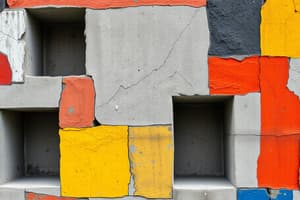Podcast
Questions and Answers
What is concrete?
What is concrete?
Structural material produced by mixing predetermined amounts of Portland cement, aggregates, and water.
What are the three different states of concrete?
What are the three different states of concrete?
Plastic, setting, and hardening.
Which of the following advantages come from reducing water content in concrete? (Select all that apply)
Which of the following advantages come from reducing water content in concrete? (Select all that apply)
- Increased resistance to weathering (correct)
- Increased permeability
- Better bond between concrete and reinforcement (correct)
- Increased compressive strength (correct)
The compressive strength of concrete is not affected by the water-cement ratio.
The compressive strength of concrete is not affected by the water-cement ratio.
What is the role of curing in concrete?
What is the role of curing in concrete?
What type of Portland cement is used where precaution against moderate sulphate attack is important?
What type of Portland cement is used where precaution against moderate sulphate attack is important?
The water required for complete hydration is about _____% of the weight of Portland cement.
The water required for complete hydration is about _____% of the weight of Portland cement.
What happens to concrete in the setting state?
What happens to concrete in the setting state?
What type of cement provides high strength at an early period?
What type of cement provides high strength at an early period?
Workability of concrete is improved by adding more water.
Workability of concrete is improved by adding more water.
Flashcards are hidden until you start studying
Study Notes
Concrete
- Concrete is a structural material, made by mixing:
- Portland cement
- Aggregates
- Water
- Quality of concrete is important for strength and durability:
- Each aggregate particle needs to be coated in cement paste
- The space between particles needs to be filled with cement paste
- Water content affects concrete strength:
- Target water-cement ratio of 0.40 for good strength
Benefits of Reducing Water Content
- Increased compressive strength
- Increased water tightness
- Increased resistance to weathering
- Improved bond between concrete and reinforcement
- Less volume change
States of Concrete
- Concrete goes through three states:
- Plastic: Soft and workable, like bread dough
- Workability and cohesiveness are important in this state
- Setting: Stiffening of concrete, no longer soft
- Takes place after compaction and during finishing
- Hardening: Concrete gains strength and hardens
- Properties: Strength and durability
- Plastic: Soft and workable, like bread dough
Concrete Properties
- Workability:
- How easy it is to place, handle, compact, and finish concrete
- Strength:
- Usually measured by compressive strength using the Compression Test
- Compressive strength is related to density and air removal during compaction
- Usually measured by compressive strength using the Compression Test
- Durability:
- How long concrete lasts and resists weathering
- Curing is important for strength and durability
- Warm weather causes concrete to have a higher early strength
- Type of cement affects concrete properties, including curing time
- Too much water makes concrete weaker and less durable
- How long concrete lasts and resists weathering
Portland Cement
- Most common type of cement
- England (1824)
- Fine powder
- Made by heating limestone and clay to form clinker, then grinding and adding gypsum (2-3%)
- Portland cement is caustic, so it can cause chemical burns
Portland Cement Types
- Type 10 (Normal): Multi-purpose cement - sidewalks, water pipes, masonry units
- Type 20 (Moderate): Use when moderate sulphate attack is a concern - large piers, retaining walls
- Type 30 (High Early Strength): Provides high strength after a week or less - for fast form removal and cold weather construction
- Type 40 (Low Heat of Hydration): Lowers the rate and amount of heat generated - used in massive concrete structures, slower strength gain than Type 10
- Type 50 (Sulphate Resisting): Used in areas where soils or groundwater have high sulphate content.
Sulphate Attack
- Sulphate ions can attack concrete components, causing:
- Cracking
- Deterioration
Aggregate
- Aggregates are used in concrete to:
- Improve strength
- Reduce cost
- Types of aggregates:
- Fine (sand)
- Coarse (gravel)
- Aggregates must be strong and resistant to exposure conditions.
Workability, Strength, and Durability
- Water cement ratio impacts workability, strength, and durability.
- More water means less strength and durability.
- Aggregate grading: Well-graded aggregates improve workability
- Ensure a workable mix by:
- Adding more cement paste
- Using well-graded aggregates
- Use an admixture
- Ensure a workable mix by:
- Never try to make a mix more workable by just adding more water.
Studying That Suits You
Use AI to generate personalized quizzes and flashcards to suit your learning preferences.




